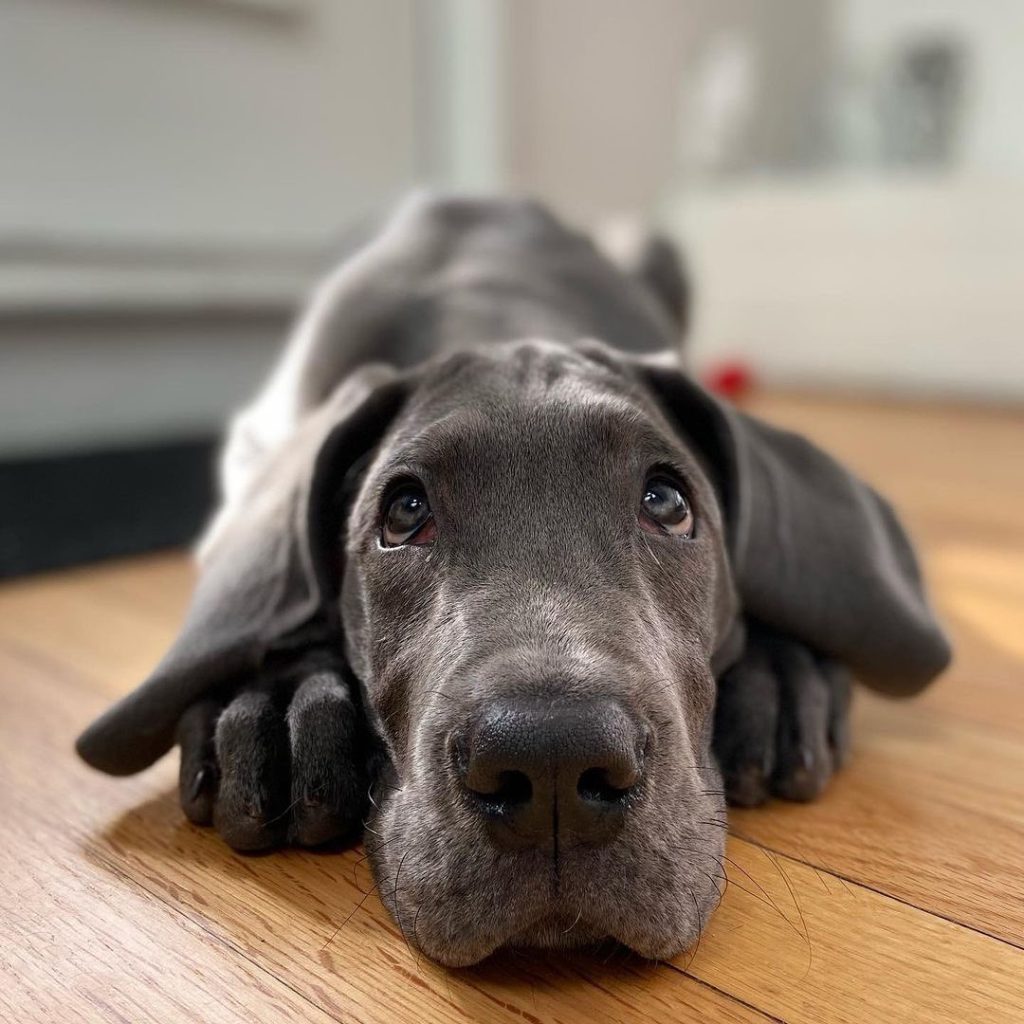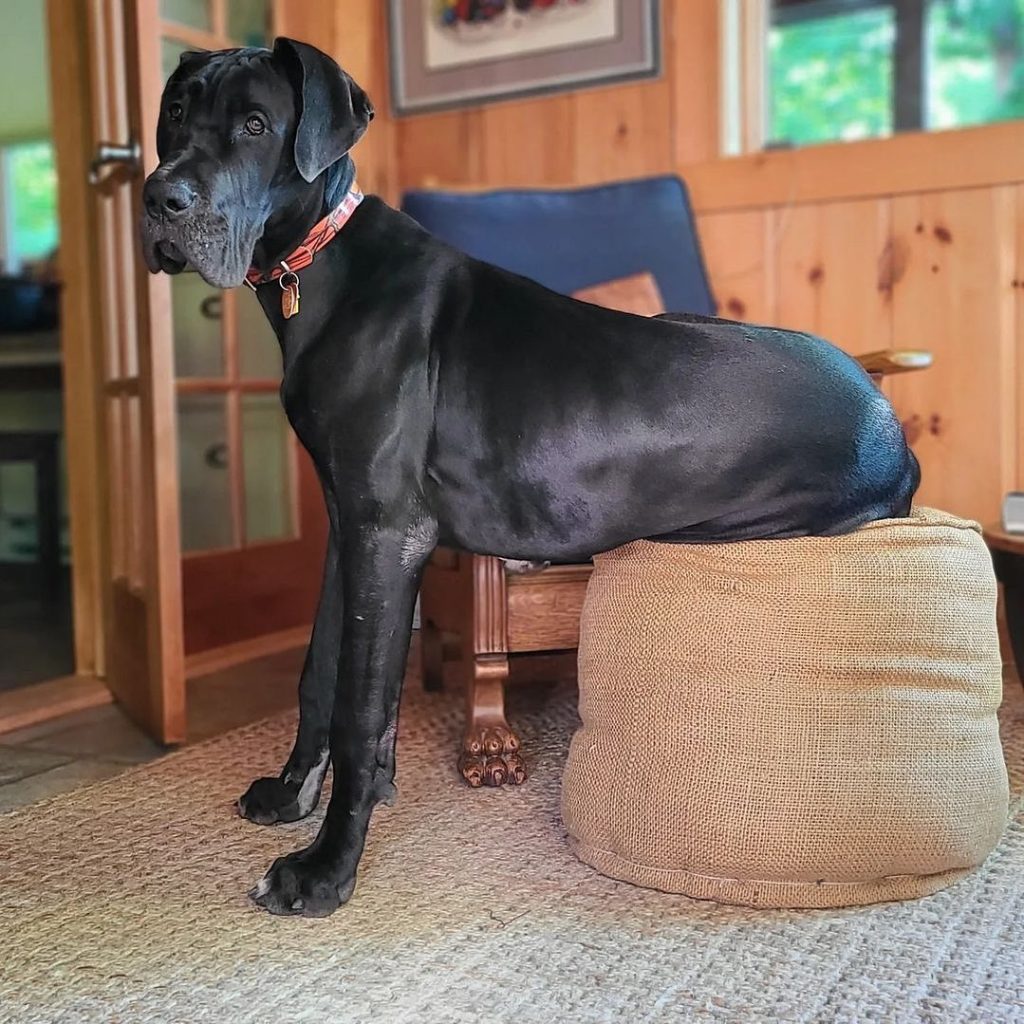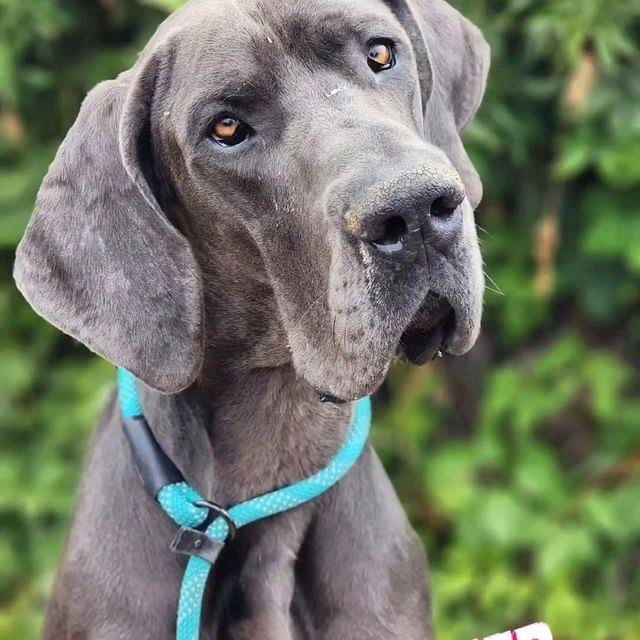
Essential Training Stages for Great Danes
Early Socialization: From 8 to 16 Weeks
Early socialization is critical during the first weeks of a Great Dane‘s life. This stage involves exposing the puppy to various experiences, people, and other animals in a controlled and safe environment. The goal is to help the puppy become comfortable and confident in different situations, reducing fear and anxiety in the future. Activities can include gentle handling by family members, introducing them to different sounds and textures, and short, positive encounters with friendly dogs and people outside the household.
Crate and House Training Basics: From 8 to 16 Weeks
Crate and house training should begin when the Great Dane puppy arrives home. Crate training provides a sense of security for the puppy and aids in establishing a routine, making it easier to manage bathroom breaks and reducing the risk of accidents in the house. House training involves regular bathroom breaks, consistent feeding times, and positive reinforcement when the puppy eliminates outside.
Advanced Socialization and Basic Commands: 3 to 9 Months
As the Great Dane grows, its training should progress to more advanced socialization and basic command training. This period is crucial for reinforcing positive social behaviors and beginning the foundation of obedience. Basic commands like ‘sit,’ ‘stay,’ ‘come,’ and ‘down’ are introduced. Regular, positive interactions with various people, animals, and environments are necessary.
Leash Training and Public Manners: 3 to 9 Months
Leash training is essential for the safety and control of a Great Dane. This stage focuses on teaching the puppy to walk calmly on a leash without pulling. It’s also a time to teach public manners, such as not jumping on people, behaving politely in public spaces, and reacting calmly to other dogs and distractions.
Reinforcing Training and Discipline: 9 to 24 Months
As the Great Dane enters adolescence, reinforcing earlier training and adding discipline becomes essential. This period is often marked by testing boundaries, so consistent reinforcement of rules and commands is essential. Continuing obedience training and socialization during this stage is crucial to ensure the dog matures into a well-behaved adult.
Key Training Goals for Great Danes
Preparing for the Canine Good Citizen Test
One of the significant goals in training a Great Dane is preparing them for the AKC’s Canine Good Citizen (CGC) test. This test evaluates a dog’s manners and obedience in everyday situations. It includes tasks like accepting a friendly stranger, sitting politely for petting, walking on a loose lead, coming when called, and behaving politely around other dogs. Preparing for the CGC test ensures that a Great Dane is well-mannered, friendly, and reliably trained.
Mastering Basic Obedience Commands
Basic obedience commands are fundamental for any dog, especially for a breed as large and powerful as the Great Dane. Commands like ‘sit,’ ‘stay,’ ‘come,’ ‘heel,’ and ‘down’ are essential for managing the dog’s behavior and ensuring its safety. These commands help in day-to-day activities and strengthen the bond between the owner and the dog, as they require consistent communication and mutual respect.
Establishing Respectful Behaviors
Great Danes must learn respectful behaviors to coexist peacefully with humans and animals. This includes not jumping on people, not begging for food, waiting patiently at doors, and respecting boundaries at home. Training a Great Dane to exhibit respectful behavior involves consistent reinforcement of rules and boundaries and positive reinforcement for good behavior.
Effective Training Methods for Great Danes

With their towering stature and gentle nature, Great Danes require specific training methods that emphasize mutual respect, clear communication, and positive reinforcement. Practical training for these majestic dogs involves understanding their unique temperament, physical needs, and mental capabilities. This section will explore various training methods tailored for Great Danes, focusing on command training, incorporating respect, and clear communication.
The Basics of Command Training
Training a Great Dane begins with mastering the basics. Command training is not just about teaching a dog to obey; it’s about establishing a language of communication between the dog and the owner. This is especially important for Great Danes due to their large size and strength. The basics of command training involve a few fundamental principles.
Firstly, simplicity is crucial. Commands should be simple, consistent, and distinct. A Great Dane is more likely to respond to clear and straightforward commands like “sit,” “stay,” “come,” and “heel.” These commands form the foundation of obedience and should be taught step-by-step.
Secondly, timing is everything in command training. The reward or correction must immediately follow the dog’s action. This immediate feedback helps the dog connect the behavior and the consequence, be it a treat for obeying a command or a firm “no” for undesired behavior.
Moreover, the training sessions should be short but frequent. Great Danes, like many large breeds, can have short attention spans, especially as puppies. Shorter training sessions may become counterproductive, leading to boredom or frustration. Short, consistent sessions ensure that the dog remains engaged and learns effectively.
Incorporating Respect in Training
Respect is a two-way street in the training of a Great Dane. The trainer must respect the dog as a sentient being with its personality, limits, and fears. This means understanding the dog’s body language and emotional state. Training should never involve fear or intimidation. Instead, it should be based on mutual respect and understanding.
For instance, if a Great Dane shows signs of fear or discomfort during a training session, it’s essential to recognize and adjust the training accordingly. This might mean slowing the pace, introducing new elements more gradually, or even taking a break.
Respect also means consistency in rules and expectations. Great Danes are smart enough to understand when boundaries are flexible, which can lead to inconsistent behavior. Maintaining consistent rules and routines helps the dog understand what is expected and provides security.
Communicating Clearly with Your Dane
Effective communication is crucial in training Great Danes. This breed is known for its sensitivity; it responds not just to the words used but also to the trainer’s tone of voice and body language. Training should be a mix of firmness and gentleness. The voice should be firm enough to command respect but gentle enough not to intimidate or scare the dog.
Visual cues play a significant role in training Great Danes. They are adept at reading body language and making gestures, which are practical tools for reinforcing commands. For example, a hand signal can be used alongside the verbal command for “sit” or “stay,” helping the dog understand the command more clearly.
Additionally, training should be a positive experience. Positive reinforcement, such as treats, praise, and affection, should reward desired behavior. This makes the training process enjoyable for the dog and strengthens the bond between the dog and the trainer.
Furthermore, it’s essential to be patient and adaptable. Each Great Dane is unique, and what works for one dog may not work for another. Training methods may need to be adjusted based on the individual dog’s personality, learning style, and response to different techniques.
Advanced Training Techniques for Great Danes
Training a Great Dane involves more than just the sit, stay, and come basics. Given their size and strength, advanced training techniques are essential to ensure they are well-behaved and controlled, especially in challenging situations. This section delves into more sophisticated training methods, focusing on enhancing leash skills, ensuring consistent behavior, and addressing specific behavioral challenges.
Enhancing Leash Skills and Outdoor Etiquette
Great Danes can be quite imposing due to their size, and proper leash training is necessary to manage them. Here are some advanced techniques to enhance leash skills and outdoor etiquette:
- Mastering the Heel Command: This command is crucial for controlling your Great Dane during walks. Training your Dane to heel involves teaching them to walk calmly by your side, neither pulling ahead nor lagging. This requires consistent practice, using treats and praise to reward the desired position. Start in a quiet environment and gradually introduce distractions as your Dane becomes more proficient.
- Distraction Training: Great Danes, like all dogs, can easily be distracted by their environment. Training them to maintain focus on the owner despite distractions is critical. This involves practicing commands in different settings, gradually increasing the level of distraction. Start with minimal distractions, gradually moving to busier environments like parks or streets, always rewarding focus and calm behavior.
- Off-Leash Training: While Great Danes should primarily be kept on a leash for safety, off-leash training in controlled environments can enhance their obedience and trust. Start in a secure, enclosed area and practice basic commands, gradually giving more freedom. Always ensure your Dane responds to recall commands reliably before attempting off-leash walking in any open space.
Consistency in Training and Behavior Correction
Consistency is the backbone of practical dog training. Here are some strategies to ensure consistent training and behavior correction:
- Immediate Correction: It’s essential to correct undesirable behavior as soon as it occurs. Whether it’s jumping, unnecessary barking, or nipping, immediate, gentle correction helps the dog understand which behaviors are unacceptable. Use a firm voice and redirect their attention to a more appropriate behavior.
- Consistent Reinforcement: Regular practice is vital in reinforcing commands and good behavior. This doesn’t mean lengthy training sessions; short, frequent sessions are more effective. Repeat commands daily, and always use the exact words and gestures to avoid confusing your dog.
- Gradual Increase in Challenges: As your Great Dane masters basic commands, gradually increase the difficulty of tasks. This could involve more extended periods of staying in the ‘sit’ or ‘down’ position, practicing commands in more distracting environments, or learning more complex commands like ‘roll over’ or ‘play dead.’
Addressing Specific Behavioral Challenges
Great Danes may develop specific behavioral challenges that require focused training:
- Resource Guarding: This is a common issue where the dog guards food, toys, or other objects. Training involves teaching your Dane that giving up these items will result in something positive, like a treat or praise. Practice exchanging the guarded item with something of higher value and returning the original item, reinforcing that there’s no threat to their resources.
- Jumping Up: A jumping Great Dane can be intimidating due to their size. Training your Dane to greet people politely without jumping is crucial. This involves ignoring the jumping behavior (no eye contact, no talking) and rewarding them with attention and treats when all four paws are on the ground.
- Barking Control: Excessive barking can be a nuisance. Training should focus on understanding triggers and teaching a ‘quiet’ command. Observe what causes excessive barking and try to eliminate these triggers if possible. When they bark, use the ‘quiet’ command and reward them with a treat when they obey.
- Advanced Command Training: Beyond basic commands, teaching your Great Dane more complex commands can be mentally stimulating and helpful. Commands like ‘fetch,’ ‘find it,’ and ‘speak’ not only provide mental stimulation but also enhance the bond between you and your dog.
- Problem-Solving Games: Great Danes are intelligent, and engaging them in problem-solving games can be highly beneficial. Use puzzle feeders, hide-and-seek games, or homemade obstacle courses to challenge their minds and keep them engaged.
Special Considerations for Great Dane Puppies

Raising a Great Dane puppy comes with unique challenges and considerations. These gentle giants increase, both in size and strength, making early training and socialization critical. The following explores vital aspects to consider when training Great Dane puppies, focusing on early socialization, the importance of positive reinforcement, and structuring practical training sessions.
Importance of Early Socialization
Early socialization is pivotal in shaping the temperament and behavior of a Great Dane. This process should start as soon as the puppy is brought home. The critical socialization period for a puppy is between 8 and 16 weeks. During this time, the puppy is exceptionally receptive to new experiences, which can impact their behavior as adults.
Socialization involves exposing the puppy to various environments, people, sounds, and other animals in a safe and controlled manner. This exposure helps the puppy become well-adjusted and reduces the likelihood of fear-based behaviors, such as aggression or anxiety, later in life. It’s vital to ensure that these experiences are positive. Adverse experiences during this formative period can have the opposite effect, leading to lasting fears and behavioral problems.
Critical elements of early socialization include:
- Exposure to Different People and Animals: Introduce your Great Dane puppy to a diverse range of people, including children and other friendly animals. This helps them become comfortable with various shapes, sizes, and behaviors.
- Familiarization with Different Environments: Take your puppy to parks, urban streets, and the countryside. The more varied the environments, the more adaptable your puppy becomes.
- Introducing Various Sounds and Textures: Expose your puppy to different sounds (traffic, household appliances, etc.) and walking surfaces (grass, pavement, gravel) to broaden their comfort zone.
Positive Reinforcement in Training
Positive reinforcement is a highly effective training method for Great Dane puppies. This approach involves rewarding the puppy for good behavior encouraging them to repeat it. Rewards can be treats, praise, or playtime — anything the puppy finds enjoyable.
Using positive reinforcement has several benefits:
- Builds Trust: Positive reinforcement helps build a strong bond of trust between the owner and the puppy. The puppy learns to associate obeying commands and good behavior with positive outcomes.
- Encourages Learning: Puppies are more likely to engage in training sessions that are fun and rewarding. This method turns learning into a positive experience, making the puppy more receptive to training.
- Reduces Fear and Anxiety: This method avoids the use of fear or punishment, which can lead to anxiety and stress in puppies. A stress-free environment is conducive to effective learning.
Structuring Short and Effective Training Sessions
With short attention spans, Great Dane puppies benefit from short, focused training sessions. These sessions should be:
- Brief and Frequent: Instead of long, drawn-out training sessions, opt for shorter sessions multiple times daily. This keeps the puppy engaged and prevents them from becoming bored or overwhelmed.
- Focused on a Single Command or Behavior: Each session should focus on one command or behavior. This allows the puppy to concentrate on learning that specific command without confusion.
- Fun and Rewarding: Make each training session enjoyable. Use play as part of the training to keep the puppy interested. Remember, a happy puppy is more likely to engage and learn.
In conclusion, training a Great Dane puppy requires patience, consistency, and a positive approach. Early socialization sets the foundation for a well-behaved adult dog, while positive reinforcement and appropriately structured training sessions facilitate effective learning. By understanding these considerations, owners can ensure their Great Dane puppies grow into well-mannered, confident, and happy adult dogs.
Leash Training and Safety Measures

Using Harnesses for Better Control
In leash training Great Danes, harnesses play a significant role in ensuring both the dog’s and the handler’s safety. Due to their size and strength, Great Danes can unintentionally pull or lunge, making control a key concern. A harness can be an effective solution, offering several advantages over a traditional collar.
A harness provides better control over a Great Dane, particularly for puppies or dogs still mastering leash etiquette. It distributes the pressure across a broader area of the dog’s body, minimizing the risk of neck strain or injury. This is especially beneficial for energetic puppies who might pull vigorously on a leash.
The Importance of Consistency in Training
Gentle but Firm Training Approach
A gentle but firm approach is fundamental in training Great Danes. This method emphasizes the importance of consistency in both commands and responses. Being gentle means respecting the dog’s nature and temperament, using positive reinforcement and patience. Being firm involves setting clear boundaries and rules and ensuring the dog understands what is expected.
This balance is crucial for Great Danes. Their size demands firm control, but their sensitive nature requires a gentle touch. A consistent, gentle, firm approach ensures the dog feels secure and understands its boundaries, leading to a well-adjusted and obedient canine companion. It’s about guiding, not forcing, and rewarding good behavior while calmly correcting mistakes.
Consistency in this approach helps the Great Dane understand and trust their owner, fostering a strong bond and mutual respect. It’s a method that trains the dog effectively and nurtures a positive, lifelong relationship.
Addressing Undesirable Behaviors in Great Danes
Redirecting Negative Actions
In training Great Danes, addressing and redirecting negative behaviors is crucial. When a Great Dane exhibits an undesirable action, like jumping or excessive barking, it’s crucial to intervene promptly. Redirecting involves guiding the dog towards an acceptable behavior when the undesired behavior occurs. This immediate response helps the dog understand the correlation between their actions and your guidance. Consistency in redirecting and reinforcing the desired behavior is vital to practical training.
Promoting Desirable Behaviors
Alongside addressing negative behaviors, actively promoting and reinforcing desirable behaviors is equally essential. This involves recognizing and rewarding good behavior every time it occurs. For instance, when a Great Dane calmly greets a visitor without jumping, immediate praise or a treat reinforces this behavior. Encouragement for good behavior should be enthusiastic and consistent, making it clear to the dog that this is the preferred action.
Fostering desirable behaviors in Great Danes is not just about rewards; it’s also about creating an environment where positive behaviors are naturally encouraged. This includes regular exercise, mental stimulation, and consistent interaction with the dog, which helps channel their energy positively.

Concluding Thoughts on Great Dane Training
Training a Great Dane is a rewarding journey that strengthens the bond between owner and dog. Consistency, patience, and understanding are vital to nurturing a well-behaved, confident, and happy Great Dane.
